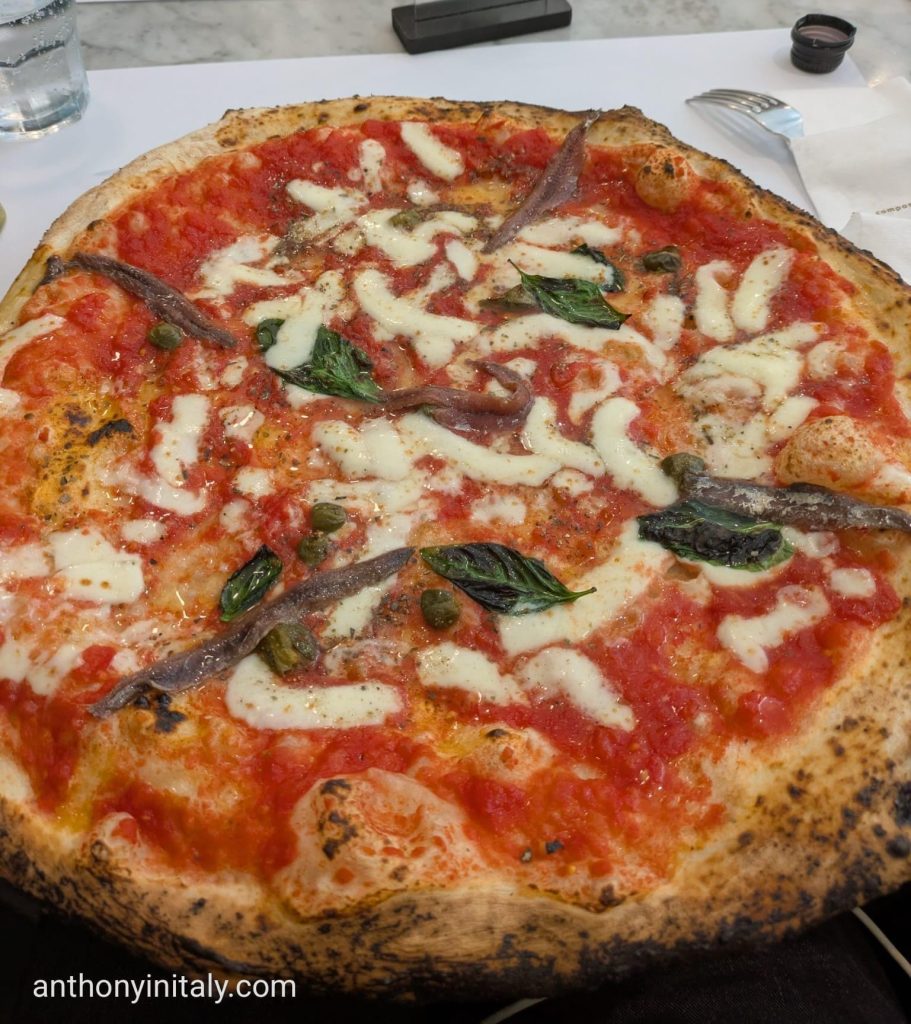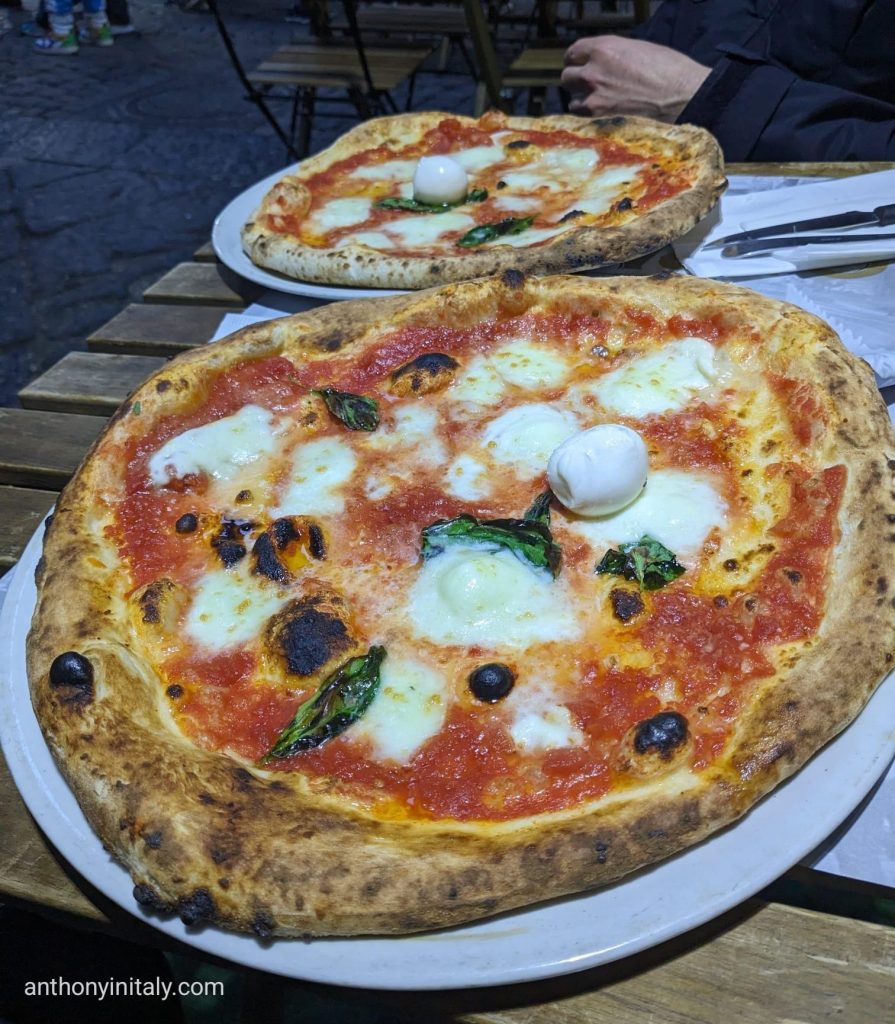How to Find Good Pizza in Italy (Because Bad Pizza Exists)
Pizza in Italy should be a no-brainer, right? It must all be good.
Most of it is. But if you don’t know what to look for, you might walk away disappointed, going back home telling your friends that pizza in Italy is overrated.
I’ve had some pretty forgettable pizzas in my four years living here, and they were almost always in places that looked the part but got the fundamentals wrong. You don’t need to be in Naples to find a good one, though of course that helps. Even if you’re passing through the north on a bigger Europe trip, you owe it to yourself to find the right thing.
I could give you a list of what I think are the best pizza places in half a dozen towns across Italy, and I’ll share a few at the end. But what’s far more useful is knowing how to find good pizza yourself. You might be in a small town where I don’t have a recommendation, and I want you to be able to spot the real thing anywhere.
Except where noted, I’m talking about Neapolitan-style pizza, which is the traditional pizza most people outside Italy think of when they picture “Italian pizza.” It’s the soft, poofy, slightly charred one that’s become the global standard.

You Don’t Need a List, You Need Eyes
You don’t need my list, and you definitely don’t need to rely on “one-bite” reviews from some rich guy on Instagram. You just need to know what to look for.
When I’m in a new city, I open Google Maps, type “pizza,” and start scrolling through the photos. That’s where the truth is.
Sure, I’ll glance at the reviews. I’m not going anywhere with a two-star average. But reviews only tell part of the story. The photos tell me almost everything I need to know.
Let’s use Venice as an example. I love Venice, but between the tourists and the logistics of running a wood oven on a floating city, it’s not the best place for pizza. Most of the pizza in Venice, in my experience, is just bland, made to satisfy the uninformed tourist’s checklist item of eating pizza on a canal while gondoliers pass by singing. Or you’ll find pre-made round pizzas cut and served by the slice. That isn’t necessarily bad, it just usually is in Venice. More on pizza by the slice later.
Here’s what I look for.
1. The Crust
This is where it all starts.
You want a crust that’s alive: puffed up, slightly blistered, and with that light char from a hot oven. It should look like something you could rest your head on and then wake up and eat.
If it looks flat, pale, or dry, skip it. That dough probably wasn’t fermented properly, which means it’ll taste like cardboard.
(This is why it’s important to note that we’re talking about Neapolitan-style pizza here. Roman pizza, which we’ll get to later, does look flatter and drier. That’s intentional.)
In authentic Neapolitan pizza, the crust, or cornicione, should be soft, airy, and slightly chewy, with small leopard-like char spots. That’s the sign of proper fermentation and heat.
2. The Sauce
A good sauce has texture. You should be able to see bits of crushed tomato rather than something perfectly smooth.
According to Neapolitan standards (Associazione Verace Pizza Napoletana), the sauce is made from peeled San Marzano or similar tomatoes that are hand-crushed, not cooked and not pureed.
If it looks bright red and shiny like ketchup, that’s a bad sign. That’s usually a fast-cooked sauce made for tourists.
3. The Cheese and Toppings
Less is more.
If you see a mountain of cheese, a dozen toppings, or the pizza already sliced before it reaches your table, walk away. In Italy, pizza isn’t about excess. It’s about balance.
A Margherita is still the benchmark. If a pizzeria can’t make that perfectly, nothing else on the menu will be good either.

4. The Oven and the Menu
When you’re walking by, peek inside. Do you see a real wood-fired oven? That’s always a good sign.
Then look at the menu. If it has every type of pasta, steak, seafood, and pizza, that’s not a pizzeria. It’s a restaurant trying to please everyone.
The best pizza spots focus almost entirely on pizza, maybe with a few simple starters or desserts.
That said, some Neapolitan pizzerias also serve a few pasta dishes, especially seafood ones, as part of offering a full Napolitano experience. That’s normal, as long as the pizza still takes center stage.
Neapolitan vs. Roman Pizza (and Why It Matters)
When most people picture “authentic Italian pizza,” they’re thinking of Neapolitan-style: soft in the center, poofy crust, cooked in a scorching oven for about 90 seconds. It’s the classic.
But Italy has regional variations, and Roman pizza is just as interesting.
- Pizza tonda romana – thin, crispy, round pizza that cracks when you cut it. Personally, I prefer it, though it’s harder to find.
- Pizza al taglio – rectangular slices sold by weight, often eaten standing up or on the go.
Both can be excellent when done right. Fresh dough, quality olive oil, and simple toppings are what make or break them.
Just remember that al taglio pizza will always be pre-cut and pre-made, but in a good shop, it’s being sold within minutes of coming out of the oven, not hours later.
Don’t Overthink the City
You don’t have to be in Naples to eat great pizza.
Some of my favorite pizzas have been in Rome, Bologna, and even small towns in Umbria.
Good pizza is everywhere in Italy, and so is bad pizza. The trick is recognizing which is which.
If you’re in a tourist-heavy area, don’t panic. Just walk a few streets away from the main piazza. Look for a place filled with locals. A short, focused menu is a good sign. And if a Margherita costs around €7–10 instead of €18, you’re probably in the right spot.
📋 Planning your Italy trip? Download my free Italy Trip Planning Checklist — packed with real advice, not fluff. Great for first-timers or return travelers who want to avoid mistakes (like picking the wrong pizza). Get the checklist here.
A Few of My Favorites (Because I Know You’ll Ask)
I won’t list every place I’ve ever loved, but here are a few that have earned repeat visits:
Naples: Sorbillo is famous, but for good reason. I also like Attanasio and Pizzeria I Decumani. Pizza in Naples is held to a pretty high standard, so it’s actually hard to find bad pizza there.
Rome: Il Carroccio for Neapolitan style (Via del Carroccio). I Commensali for Roman-style pizza tonda (Via Calabria). For pizza al taglio, go to Bona | Pizza Roma, which has multiple locations around the city.
Florence: Il Pizzaiuolo (Via dei Macci) for Neapolitan-style.
Milan: Napule è – Fratelli Coppola (Via Alfredo Cappellini) or Nàpiz’ Milano (Viale Vittorio Veneto).
Perugia: Pizzeria Mediterranea Da Davide.

Final Thought
Pizza in Italy shouldn’t be a guessing game.
Once you know what good dough looks like, smells like, and feels like, you’ll start spotting the real thing everywhere. You don’t need to chase hype or five-star reviews. Just pay attention to the crust.
Because when that first bite hits, that mix of chewy, charred, salty, tangy perfection, you’ll understand why Italy does it best.
And you won’t be one of the people going home saying pizza here is overrated.

